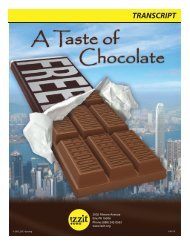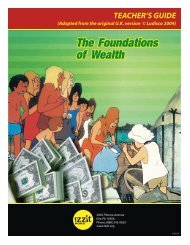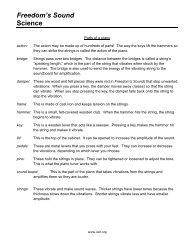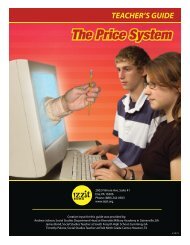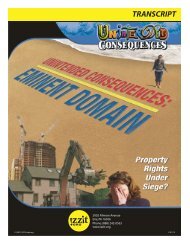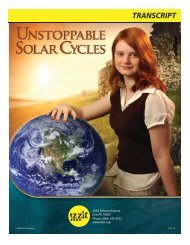The Utimate Resource: Eusebio's Dream - Izzit.org
The Utimate Resource: Eusebio's Dream - Izzit.org
The Utimate Resource: Eusebio's Dream - Izzit.org
- No tags were found...
You also want an ePaper? Increase the reach of your titles
YUMPU automatically turns print PDFs into web optimized ePapers that Google loves.
<strong>The</strong> Ultimate <strong>Resource</strong>: Eusebio’s <strong>Dream</strong>Preview Questions and Key Terms<strong>The</strong> questions and definitions below will help prepare students for the video by prompting thought anddiscussion about the topic. <strong>The</strong> italicized answers to selected questions are provided to enhance thestudents’ understanding of the video.1. Locate Peru on a map. Which ancient empire had its capital here?2. How do you think the descendants of the Incas live today?3. What is subsistence farming?4. Define: assets, indigenous, rule of lawAssets – total resources of a person or business, as cash, notes and accounts receivable,securities, inventories, goodwill, fixtures, machinery, or real estate.Indigenous – originating and living or occurring naturally in an area or environment;native.Rule of law – the principle that every member of a society, even a ruler, must follow thelaw; a legal system in which rules are clear, well-understood, and fairly enforced,including property rights and enforcement of contracts; the doctrine that all people areequal before the law, and that the government is subject to the law; the absence of arbitraryexecutive power.5. What are property rights?Property rights are the rights to use, control, and obtain the benefits from a good orservice.6. Do you own a car, computer, or iPod? As an owner, what rights do you have? Other thanusing it whenever you choose, what else can you do with your property that others cannot?Private property rights are property rights that are exclusively held by an owner andprotected against invasion by others. Private property can be transferred, sold, ormortgaged at the owner’s discretion.*7. In the United States, with assets such as cars, houses, and land, how do we know who ownswhat? How do we prove ownership?8. Other than selling their assets, how else can people use those assets to get ahead?* Source: Economics, Private and Public Choice, by Gwartney, Stroup, Sobel and MacPherson2
Name:Date:<strong>The</strong> Ultimate <strong>Resource</strong>: Eusebio’s <strong>Dream</strong>Viewing Guide – Page 11. How long has Eusebio’s family been farming the same plot of land?2. Although Eusebio’s family depended upon the land for their livelihood, what important legaldocument were they lacking?3. Over the centuries, the sacred valley has had many owners. <strong>The</strong> ________________________Empire ruled the land until it was conquered by the __________________________.4. For centuries, who has dictated land ownership in Peru?5. What did the stranger from the city show to Eusebio’s grandfather?6. Why was life hard for Eusebio when he was young?7. <strong>The</strong> ___________________________ that were established by the Peruvian government in1969 were part of a socialist system in which private ownership of land was not allowed.3
Viewing Guide – Page 28. What choice did Eusebio have under this new (1969) arrangement? Did the hardships end?9. According to Hernando de Soto, how many people in the world are locked out of the capitalistsystem?10. A) What does de Soto say the majority of people lack that leaves them outside the capitalistsystem? B) What does he say is essential for “playing the capitalist game”?A1.______________________________________________________________________A2.______________________________________________________________________A3.______________________________________________________________________B. _______________________________________________________________________11. What do Hernando de Soto and the Institute for Liberty and Democracy fight for?12. What is the cause for celebration in Eusebio’s village?4
<strong>The</strong> Ultimate <strong>Resource</strong>: Eusebio’s <strong>Dream</strong>Discussion Questions1. Why did Eusebio’s family have no choice but to work the land for others?1. Why is the land like gold to Eusebio?2. Why do people need assets in order to “play the capitalist game”?3. What are property rights?4. Why is proof of ownership important?5. What prevented Eusebio from being able to borrow against the value of his land or benefit fromthe sale of the land?6. According to Hernando de Soto, why is it important to make capitalism friendly to the majoritywho are currently outside the system?7. Before they gained legal title to their land, were the villagers secure in their property? Explain.8. Were the people better off during the time when the government did not allow privateownership of the land and the farmers worked in cooperatives? Why or why not?9. How will having legal title enable the villagers to improve their lives? Give examples.10. How can borrowing money help people to become better off?11. What is the rule of law? How do property rights and the rule of law protect the least powerfulin society from exploitation by the powerful?12. In general, it is ownership that gives people the incentive to maintain or improve property.Why do you think Eusebio and the other villagers tended the land even though they had noofficial property rights?13. In developed countries such as the United States, property rights are exchanged by buying andselling. How and why is the process different in undeveloped countries? Compare theestablishment of property rights in Peru to the settling of the American West under theHomestead Act.14. What are some limitations on property rights here in the United States? How do theserestrictions affect owners?5
<strong>The</strong> Ultimate <strong>Resource</strong>: Eusebio’s <strong>Dream</strong>Answer KeyViewing Guide:1. 100 years2. Title3. Inca; Spanish Conquistadors (Spanish or Conquistadors also acceptable)4. Government5. Title6. In order to stay on the land, he had to work for others. He worked hard but earned little.7. Cooperatives8. Work for the cooperative or move off the land. <strong>The</strong> hardships did not end.9. Two-thirds of the world’s people, or 4 billion people.10. A. Legal means of identification; legal business association; property rightsB. Assets11. Property rights and the rule of law.12. <strong>The</strong> villagers have each received legal title to their land.Quiz:1. B) Peru2. C) Gold3. A) Government4. D) By moving rocks to redirect a nearby stream5. <strong>The</strong> land6. Title7. Two-thirds of the world’s people, or 4 billion people.8. Property rights and the rule of law.9. <strong>The</strong> villagers have each received legal title to their land.10. Borrow money for seed; get a loan for children’s education; sell all or part of their land; passthe land on to their children.7
<strong>The</strong> Ultimate <strong>Resource</strong>: Eusebio’s <strong>Dream</strong>Enrichment ActivitiesEssay Topics:1. How do property rights and the rule of law ensure that no one receives special treatment fromthe government?2. In what ways does the right to own property allow people to improve their lives?3. Write a letter from Eusebio to an elected official about the importance of property rights.Report:Research and write a report about the work of the Institute for Liberty and Democracy.Game:<strong>The</strong> Magic of Markets: How Trade Creates WealthThis game is a fun and effective way to help students understand the dynamics of markets and theimportance of well-defined and enforceable property rights. A complete description and demo video ofthis game are posted on the website for the Foundation for Teaching Economics at:http://www.fte.<strong>org</strong>/teachers/programs/efl/lessons/mon/eflmon2.htm. Through this activity, thestudents can experience firsthand the incentives and results of different “rules of the game.”<strong>The</strong> game involves students in a trading simulation designed to illustrate a complex marketplace inwhich goods and services are traded. Students use this experience to investigate the conditions thatencourage or discourage trade among individuals.After playing the standard version of the game, to highlight the concepts presented in Eusebio’s<strong>Dream</strong>, play a variation of this game that demonstrates the importance of property rights. People canhave incomplete property rights (e.g., can only trade with a member of the same sex). A few peoplecan have tenuous rights (they are identified as having rights that are only enforced for the first threeminutes). <strong>The</strong> teacher knows who these people are and can take their goods at any time after the first 3minutes. See how these people make trades differently than those who have complete and enforcedrights.8
We are very interested to learnhow you use our material. Pleaseshare your experiences or lessonplan ideas by emailing usat info@izzit.<strong>org</strong>.2002 Filmore Ave • Suite #1 • Erie, PA 16506Phone: 814.833.6950 or Toll Free: 888.242.0563Fax: 814.833.7415 or Toll Free: 866.526.1484Email: info@izzit.<strong>org</strong> • Web: www.izzit.<strong>org</strong>



